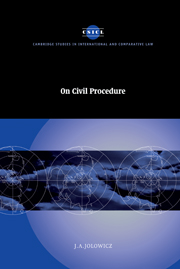Book contents
- Frontmatter
- Contents
- Preface
- List of abbreviations
- Introduction
- I The litigation process
- II Protection of diffuse, fragmented and collective interests
- III Procedural modes
- IV The parties and the judge
- V Recourse against judgments
- VI Procedural reform
- Index
- CAMBRIDGE STUIDES IN INTERNATIONAL AND COMPARATIVE LAW
Preface
Published online by Cambridge University Press: 18 December 2009
- Frontmatter
- Contents
- Preface
- List of abbreviations
- Introduction
- I The litigation process
- II Protection of diffuse, fragmented and collective interests
- III Procedural modes
- IV The parties and the judge
- V Recourse against judgments
- VI Procedural reform
- Index
- CAMBRIDGE STUIDES IN INTERNATIONAL AND COMPARATIVE LAW
Summary
The new Civil Procedure Rules, which are based on and broadly follow the recommendations made by Lord Woolf in his Reports of 1995 and 1996, came into force on 26 April 1999. They are supposed to give a completely new start to English civil procedure, and Lord Woolf himself is reported as having said, in a speech made in February 1999, that the White Book would be of ‘historic interest’ only, that looking back to old cases would ‘mislead rather than inform on the new position’ and even that ‘all learning should be forgotten’ {Law Society Gazette, Guardian Issue, 24 February 1999, p. 4).
It is only fair to Lord Woolf to suppose that he did not intend his words to be taken literally, but, be that as it may, this book reflects the conviction that the slate was not, and could not have been, wiped clean and a completely new system introduced in April 1999. Reformers are men and women of their time. They can learn from their past, but they cannot wholly escape from it. Even the French Revolution could not produce a truly radical civil code: its draftsmen were, inevitably, lawyers and judges of the pre-Revolutionary era who ‘could not be expected to forget their education, experience, and preconceptions’ (René David, French Law (1972), p. 12). In fact, though the new rules have introduced a number of significant innovations and have changed the style and language of our procedural law, what we have now is clearly recognisable as a development, not a rejection and replacement, of what went before. That this development, in conjunction with some earlier changes, may have l -term unintended conseq ences for the character of our procedure, is another matter.
- Type
- Chapter
- Information
- On Civil Procedure , pp. ix - xiiPublisher: Cambridge University PressPrint publication year: 2000

